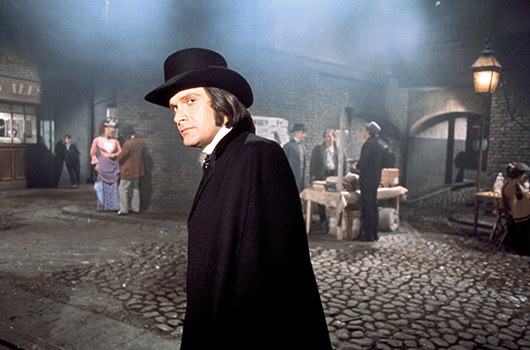
Dr Jekyll & Sister Hyde (Hammer 1971)
With the lush feel of a modern day musical like Carol Reed’s Oliver! (1968), interacting crossover cultural themes such as Jack the Ripper and Burke and Hare, and a sexually fluid central character, Dr Jekyll & Sister Hyde is an electrifying piece of cinema which effortlessly pushes genre limitations, cementing it as one of the more notable British films of the early 1970s.
Its very gestation was due to a new way of doing things for the established British House of Horror, paving the way for a level of boldness which would be essential to make such an outlandish idea work. Hammer’s decision to welcome input from independent writers and producers had been reasonably innovative, although the results had been patchy and unreliable.
Check out our full-length feature on Dr Jekyll & Sister Hyde in Classic Monsters of the Movies issue #10
Dr Jekyll & Sister Hyde had been the brainchild of producer Brian Clemens, famed for The Avengers, but when he first mentioned it to director Roy Ward Baker in the Elstree canteen, people weren’t entirely sure how to take it. “We all thought it was a brilliant joke,” recalled Baker, “but of course, he was quite serious.”
Sir James Carreras, on the other hand, took the writer exactly at his word. “I came up with an idea: Dr Jekyll & Sister Hyde. I couldn’t believe nobody had ever done that,” said Clemens. “I mentioned it to Jimmy and he said, ‘Come up and see me in two days at Hammer House.’ When I arrived for the appointment he’d already had the poster made – that’s when I knew I had a deal.”
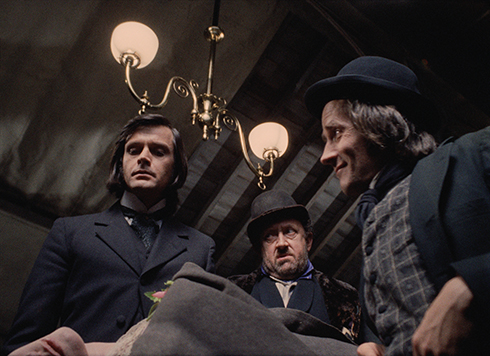
Dr Jekyll (Ralph Bates) takes his latest supplies from Burke (Ivor Dean) and Hare (Tony Calvin) in Dr Jekyll & Sister Hyde (Hammer 1971)
Receiving the nod for his Victorian setting, Clemens and his Avengers partner Albert Fennell set to work on the screenplay in October, 1970. Jimmy Sangster, Alan Gibson, Peter Sasdy and Gordon Hessler were all considered to helm the project, but in the end directorial duties were assigned to Baker, who was seen by Hammer as a reliable pair of hands and had already worked with Clemens and Fennell to great effect on The Avengers.
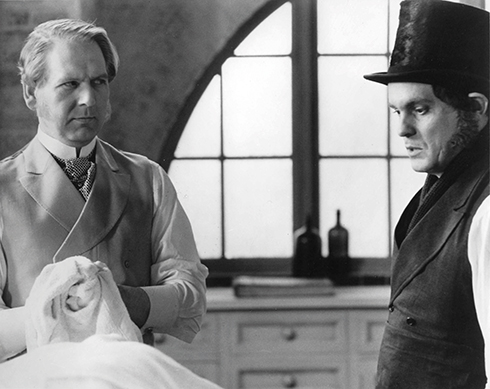
Professor Robertson (Gerald Sim) quizzes mortuary attendant Byker (Philip Madoc) over his suspicions about Jekyll in Dr Jekyll & Sister Hyde (Hammer 1971)
Ralph Bates was the new boy of Hammer Horror, having proved himself in that year’s Taste the Blood of Dracula, and was promptly cast as Victor Frankenstein in Sangster’s The Horror of Frankenstein (1970), by now being groomed as a replacement for both Lee and Peter Cushing. He was therefore the natural choice to play Jekyll. It was decided, for obvious reasons, that his female counterpart should at least resemble him, and so original suggestions of both Kate O’Mara and Julie Ege were quickly dismissed. James Carreras had no doubt about who should be cast, suggesting Jamaican-born Martine Beswick, who had been working in American television since her appearance in Hammer’s Slave Girls (1968), and was visiting friends in London at the time Dr Jekyll & Sister Hyde was in development. Calling socially on her old agent, the actress was surprised at the reception she received, as she recalls:
“She said, ‘Martine – Hammer’s looking for you! – they’re going to do a film called Dr Jekyll & Sister Hyde!’ and I went, ‘Oh, don’t be silly – what do you mean, he’s going to turn into her?’ and she said, ‘Yeah – they’re doing it!’”
The movie’s plot is as ingenious as it is well-written. Opening almost at the end, we see Henry Jekyll (Bates) committing the grisly murder of a prostitute in London’s East End, escaping back to his lab with his prize, a gland from his victim which he needs for some unknown reason. He sits at his desk and begins to write his confession, and we are transported back to the previous November.
Initially attempting to develop a panacea for all ills, he eventually turns his attention to creating an elixir of life. His devotion to duty is much to the chagrin of his friend and colleague Professor Robertson (Gerald Sim), a middle-aged playboy who prefers the finer, more hedonistic delicacies of life. Achieving some success with extending the life of a fly, Jekyll is elated until Robertson alerts him to the fact that the insect has changed its sex.
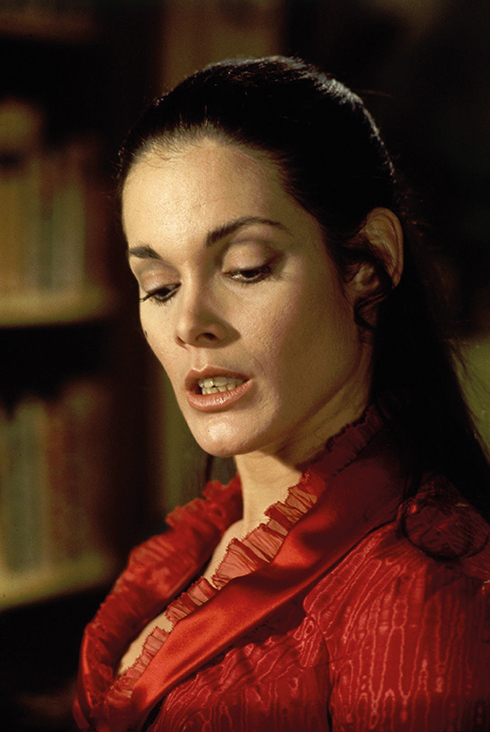
Martine Beswick excels as Ralph Bates’ wicked alter ego in Dr Jekyll & Sister Hyde (Hammer 1971)
Meanwhile, new neighbours, brother and sister Susan (Susan Brodrick) and Howard Spencer (Lewis Fiander) and their mother (Dorothy Alison), are moving into the rooms above Jekyll’s, and it’s not long before the young lass has fallen hook, line and sinker for the good doctor, whom she sees as a noble medic. As Jekyll presses on with his experiments, he turns into the sadistic Sister Hyde (Beswick) and, no longer able to procure the body parts he needs from mortuary attendant Byker (Philip Madoc), or grave robbers William Burke (Ivor Dean) and William Hare (Tony Calvin), uses the alter ego as a disguise to carry out a killing spree that he may obtain a fresh supply of the necessary gland.
In a complicated little box and cox love triangle, Howard falls for Hyde. It is not long, however, before Robertson becomes suspicious and, confronting Jekyll’s ‘sister’ with his theory, is brutally killed by her. As Hyde becomes the more dominant force of the two personalities, Jekyll decides he must be rid of her forever and, as the action comes full circle, ventures out to commit the murder we first see. But his old accomplice Hare, now blind after an angry mob cast him into a lime pit, spills the beans and leads the police to the killer’s door. A devastated Susan joins the thronging crowd as a nimble Jekyll nips out the back door, carelessly knocking a flask of corrosive liquid over his account of the case, and springs up onto the top floor window ledge. Hyde comes to the fore once more and, as the struggle for control ensues, Jekyll lets go of the guttering and plunges to his death in the street below.
It is a spectacular denouement to a superlative film whose lavish, stylised feel belies its relatively modest budget, but it is Baker’s flawless directing, symbiotic with Clemens and Fennell’s screenplay, that contributes to the triumphant mood of the movie. The script sparkles with genuinely funny one-liners, which are delivered with knowing brilliance by a remarkable cast. Steering uncomfortably close to many taboos, such as Byker’s dark propensity for necrophilia and the gender-swapping implications for the titular character(s), Dr Jekyll & Sister Hyde positively blisters with light relief humour, in particular from Dean and Calvin as the ghoulish double act, while not for a moment pulling any punches with the shocks and horror. Yet, notwithstanding all of this, there is something elegant and tasteful about the film which should have made it a genre-hopping masterpiece; sadly, its release as a double bill with Blood From the Mummy’s Tomb in October 1971 declared its intent as a horror picture, thus limiting its audience forthwith.
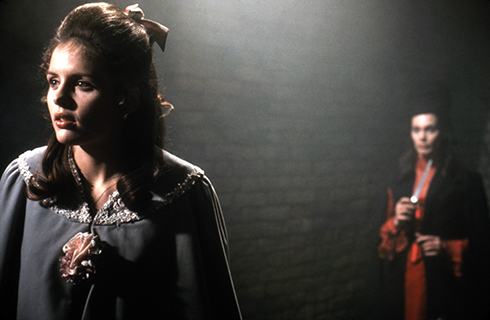
A tense moment as Hyde (Martine Beswick) stalks Susan (Susan Brodrick) through the fog-shrouded streets of Whitechapel in Dr Jekyll & Sister Hyde (Hammer 1971)
Dr Jekyll & Sister Hyde is undoubtedly both Bates and Beswick’s finest hour; the pair’s ability to inhabit the same role as efficiently as if it really were the same persona is uncanny. As philandering Robertson, Gerald Sim is divine, uttering every single line of his dialogue with a finesse that makes his interpretation so eminently watchable. Ably supported by co-stars Fiander, Brodrick and Alison, not to mention Madoc, Dean and Calvin, this is truly a top-drawer ensemble, making Dr Jekyll & Sister Hyde absolutely the sum of its parts. It is hard to find a weakness, and the whole, illustrious package is nothing short of magical.
For all its glorious execution, the film did not win at the box office, scraping together a meagre £2,376 in its opening weekend at London’s New Victoria theatre. Once on general release, the situation remained as starkly depressing; it seems audiences of the time either didn’t get the joke, or dismissed Dr Jekyll & Sister Hyde as some kind of trashy, transvestite horror flick. In reality, it is anything but. A finely crafted example of stunningly good-looking entertainment, it manages to encompass so much in its slick, 96 minute runtime and, as such, has a legacy which is arguably unique. A rare gem of individuality in filmmaking, Dr Jekyll & Sister Hyde should be cherished and appreciated for exactly what it is: a supreme example of cinematic perfection.
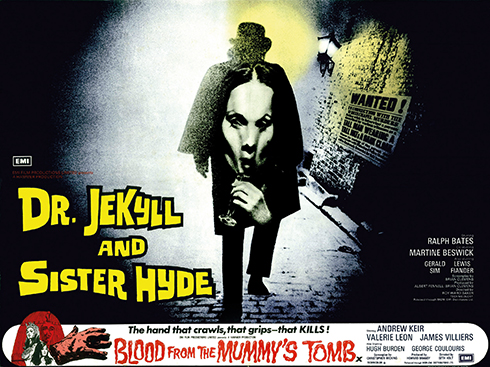











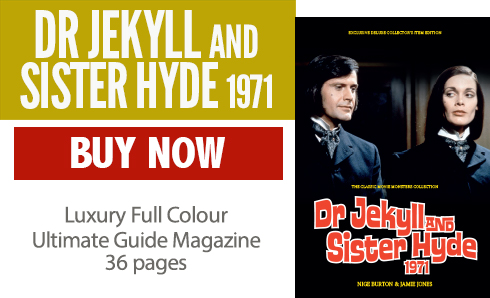
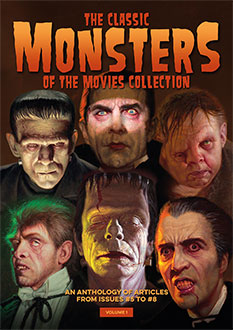
So far, I do not have this film in my DVD or VHS collection. I am looking forward to seeing what “the boys” have done with the description of this film!!!
I have a trans girlfriend. I showed her this movie (she’s gender-fluid) and it completely bowled her over! She then showed it to another (trans) friend of hers–and she went crazy over it, too! The scene where Sister Hyde is relishing her “new look” in the mirror–after her first transformation–really resonated with them. I wonder whether this has the making of a cult film for the trans (LBGTQ) community? Whether that’s its destiny or not, I completely agree that it’s one AMAZING film!